Conspiracy theories. Alcohol lobby

According to WHO , male Russians consume 23.9 liters of pure alcohol per year (Belarusians - 27.5 liters), with an average world level of alcohol consumption of 6.2 liters per year. Doctors believe that alcohol is the cause of many deadly diseases. The widespread alcoholization of the population is the main factor behind the low life expectancy in Russia. They say that this is the only country in the world where the death rate of men at liberty is three times higher than in prison (there alcohol is prohibited). In fact, alcohol has already claimed more lives than famines, epidemics, terrorist attacks and all wars in history, including World War II . Now, 3.3 million people a year die from this substance.
Alcohol is addictive, destroys the brain, liver, digestive tract and stomach. It leads to cirrhosis of the liver, pancreatic cancer, obesity, hypertension, and heart disease. Under the influence of alcohol, more than 200 diseases develop, including acute and chronic mental disorders; damage to the organs of the gastrointestinal tract occurs: gastritis, gastric and duodenal ulcers, colitis, dysbacteriosis, alcoholic hepatitis, disorders of the cardiovascular system; neuromuscular excitations, development of seizures, pathologies of the respiratory system: chronic bronchitis, pneumonia, tuberculosis, changes occur in the cerebral cortex.
Do you still think this is a regular food item? This is exactly what regulators believe that they allow to sell this substance in food stores.
')
Impact on the body

Ethyl alcohol C 2 H 5 OH is a flammable liquid that is used as a fuel, solvent or disinfectant. When ingested, it has a narcotic and toxic effect. Narcotic effects on the central nervous system are varied: C 2 H 5 OH inhibits the functions of the central nervous system, causes alcoholic stimulation, insensitivity to pain, etc. Under the action of ethanol, endorphins are secreted in the brain, according to the method of exposure, similar to opiates.
Endorphins have the ability to reduce pain, similar to opiates, and affect the emotional state. Small doses of alcohol give a feeling of relaxation and self-confidence. In high doses, it slows down the reaction and adversely affects, for example, on the eye and coordination.
Repeated alcohol intake is highly addictive and addictive, in large doses - stupor, coma, insensitivity to pain.
According to the WHO definition, a drug is a chemical agent that causes stupor, coma or insensitivity to pain. Despite this, from a legal point of view, alcohol is not officially recognized as a drug, as this substance is not included in the international list of controlled substances of the 1988 UN Convention. This is the first strange thing that is related to the regulation of alcohol.
In terms of harm to the body, impact, mortality, and the level of physical dependence, alcohol should be included in the strong drug group in almost all parameters, along with other class A drugs (prohibited ecstasy, 4-MTA and LSD). In reality, the opposite is true. Some "weak" drugs, for which science knows no cases of fatal overdose , are completely banned in Russia. And the strongest poison with narcotic effects - ethyl alcohol - is sold in every store. It's amazing.
In 2010, English psycho-pharmacist David Nutt of the University of Bristol, a member of the UK Drug Abuse Advisory Council, together with a group of experts in chemistry, pharmacology, psychiatry, as well as law enforcement officials and lawyers, analyzed the effects of 20 different drugs in terms of physical, psychological and social harm, the likelihood of drug addiction and the impact on society. A total of 16 criteria were considered.
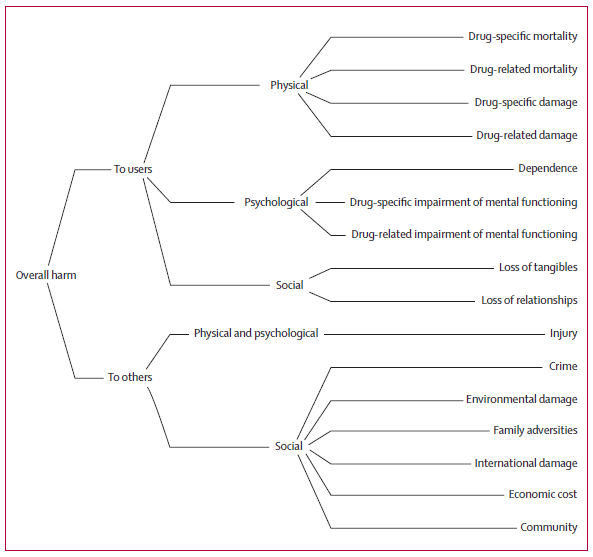
Criteria for assessing the harm of the drug. Source: The Lancet
The research results are published in the scientific journal The Lancet (doi: 10.1016 / S0140-6736 (10) 61462-6, pdf ).
According to the study, if you comply with the requirements of the current classification of drugs, then alcohol would be classified as a Class A drug. In general, the list of the most dangerous drugs in the world is as follows:
- Alcohol - 72 points
- Heroin - 55 points
- Crack - 54 points
- Methamphetamine - 33 points
- Cocaine - 27 points
- Tobacco - 26 points
- Amphetamine - 23 points
- Marijuana - 20 points
- GHB - 19 points
The following table shows the overall hazard rating of the drug and the contribution of each factor, including mortality, harm to health, the level of addiction, the destructive impact on a person’s mental abilities, economic damage (according to this indicator, alcohol and tobacco showed maximum ratings), impact on crime, damage to the family, etc.
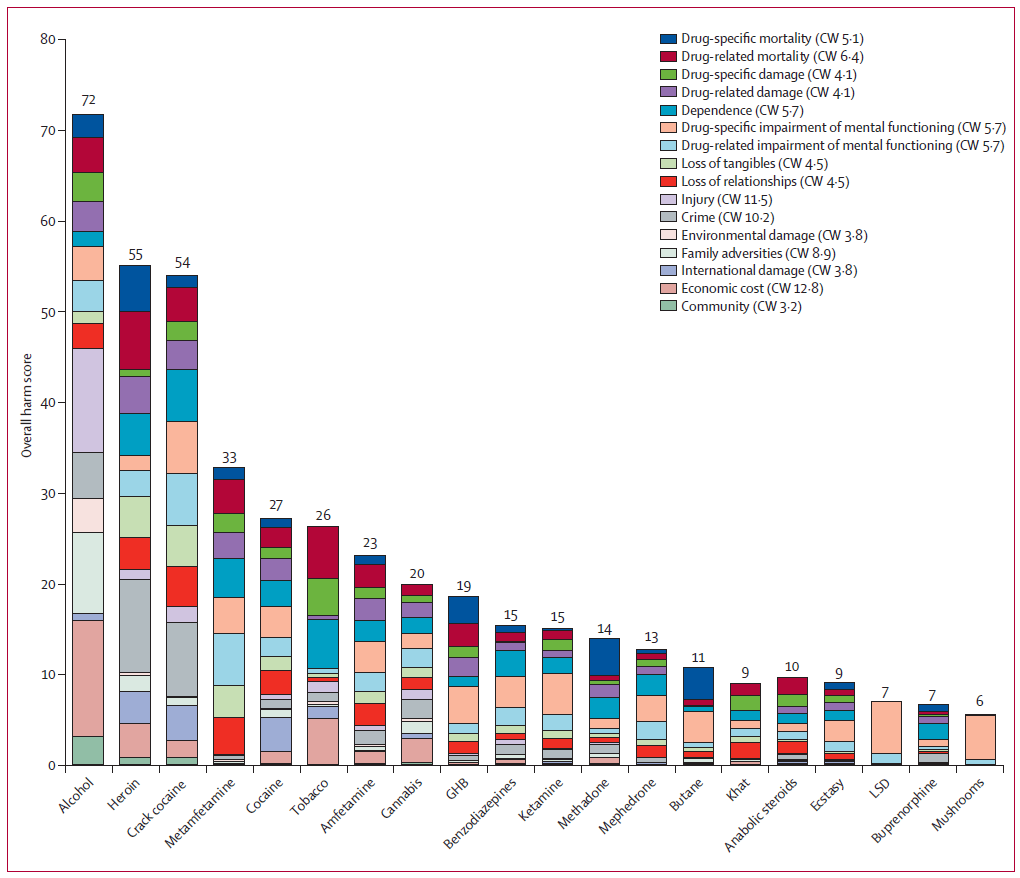
Source: The Lancet
If we classify all factors according to the degree of damage to the person who takes the substance, and the degree of damage to others, then nothing can compare with alcohol.

Substances are classified according to the degree of harm to the user and to other people. Source: The Lancet
“If alcohol was invented today, it would be outlaw, no doubt,” the authors of the scientific work are sure.
Experts believe the main problem is that the classification of drugs has not been revised for more than 40 years. It urgently needs revision, as well as the system of administrative and criminal penalties, which is currently in force. This system is completely illogical when a young girl receives 12 years in prison for smuggling one and a half tablets of ecstasy, while the distribution of the most dangerous substance, ethyl alcohol, is completely legalized for historical reasons.
How does rejection of alcohol affect the body?
Numerous studies show that even a short-term failure to take this substance has a beneficial effect on health. For example, the ability to fully concentrate on solving a problem increases. Normal sleep, metabolism. Many people say that in a month or two they feel a surge of strength, an increase in working capacity. The body is gradually cleared from the products of the oxidation of alcohol to acetaldehydes and acetic acid. A direct consequence of the refusal of alcohol - increased immunity, that is, reducing the risk of any disease.
However, if a person has already formed a certain degree of alcohol addiction, then at first it will be hard for him. The brain, which is used to constantly fighting the depressive effects of alcohol, will continue its inertia activity. This will manifest itself in excessive human agitation, nervousness, fussiness, hand trembling, etc. Only by taking a small dose of a depressant does a person “calm down” and become “normal” again.
Even a minimal dose of alcohol damages the cardiovascular system and the brain. Recovery of the nervous system is the most lengthy process. After a longer period, you can count on the restoration of memory, coordination of movements, the disappearance of nervousness and irritability.
Unfortunately, some changes in the body after a long reception of alcohol are already irreversible.
Food product?
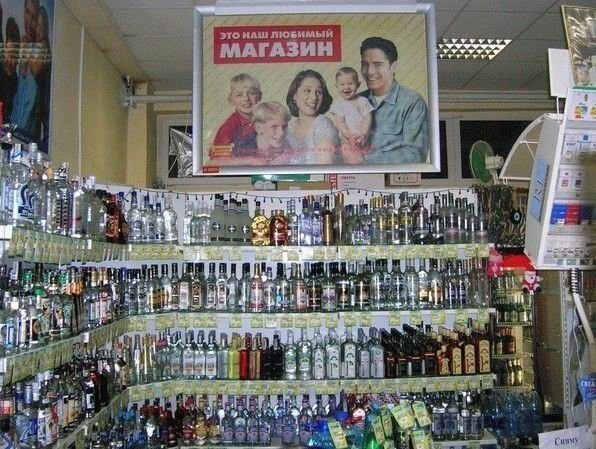
Virtually every resident of Russia has relatives or friends who have suffered from the abuse of this substance. There are dead. People in a state of severe intoxication are found on the streets of almost every city at any time of the day.
Given the powerful effect of alcohol on the body, highly addictive and millions of deaths every year, it seems rather strange - why is this substance not considered officially a drug? Why is it sold in stores next to milk and bread? Why does the state regulate the prices of alcoholic beverages so that this substance remains affordable for the majority of the population?
Foreign tourists who come to Russia are surprised at the availability of alcoholic beverages. Alcohol is sold everywhere like a regular drink, like mineral water. It can be bought literally at every corner. In the 90s, vodka was sold simply in stalls on the street, like Coca-Cola and gum.

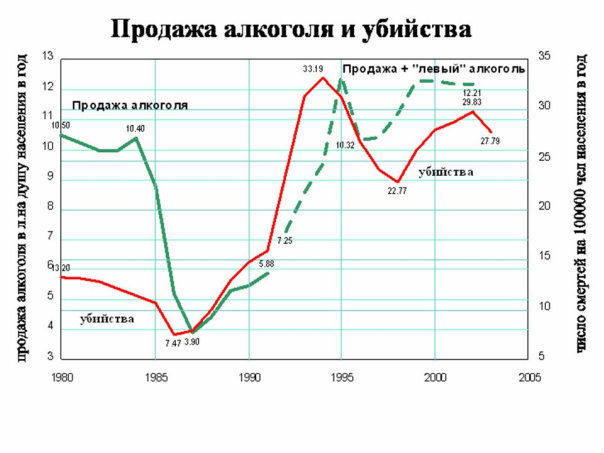
In 1911, the Russian economist-mathematician and statistician Vladimir Dmitriev wrote the book Critical Studies on Alcohol Consumption in Russia , in which he conducted a deep socio-economic analysis of the causes, nature and consequences of this single tragic phenomenon of Russian life in the late 19th and early 20th centuries. Based on statistical data, the scientist convincingly demonstrated the effect on alcohol consumption of industrial and agrarian crises, crop failures, measures to combat alcoholism. Dmitriev showed that alcohol is not an ordinary product, the generally accepted laws of consumption do not apply here . For example, during the years of crises, alcohol consumption does not decrease (as consumption of ordinary products), but increases.
In fact, as in the case of the classic drug, alcohol sales do not depend on the level of wealth of a person. An addicted person would rather starve, but still buy another “dose”.
What should the state do in this situation? It seems logical to answer that the state should strive to reduce the alcoholization of the population. The benefits to the state are obvious:
- crime will decrease;
- prisons will be unloaded;
- significantly reduce the burden on the health care system;
- life expectancy will increase;
- labor productivity will increase;
- birth rate will grow, population growth will begin.
Do you need this state? Of course you need. How to reduce the alcoholization of the population - the answer is also known, there is the experience of countries that have limited the sale of alcohol.
The key word is accessibility . Make it so that if you want alcohol can be obtained, but it should not be sold at every corner for a penny. Prohibit the sale of the substance in grocery stores. Ban the sale near schools. It is advisable to make the place of sale in remote areas, out of town. This alone will be enough to radically change life in the country, save millions of lives. Why is this not done?
Propaganda "drinking culture" and the myth of "quality" alcohol
Scientifically, alcohol is a poison for the human body. Some studies have shown that in small doses, the intake of this poison can reduce the risk of heart disease (although other studies refute this common myth). Explanation of this phenomenon, if it exists, scientists have not yet found. Presumably, certain mechanisms are activated in the body, which should protect it from the effects of the poison - thereby improving protection against certain diseases.
Approximately the same tonic effect on the body has a reception of some other poisons in small quantities.
Nevertheless, the side positive effects of alcohol intake, even if they exist, can not be compared with the enormous harm that this substance causes, whose place is in the classification of the most dangerous drugs of class A.
In this regard, you need to understand what are the theses about the "culture of drinking" and "quality" alcohol, which are distributed by representatives of the alcohol lobby.
The meaning of the thesis of "quality" alcohol is quite transparent. Thus, manufacturers are trying to maintain their lobbying position and increase market share. How poison can be “quality” or “poor quality” is a rhetorical question.
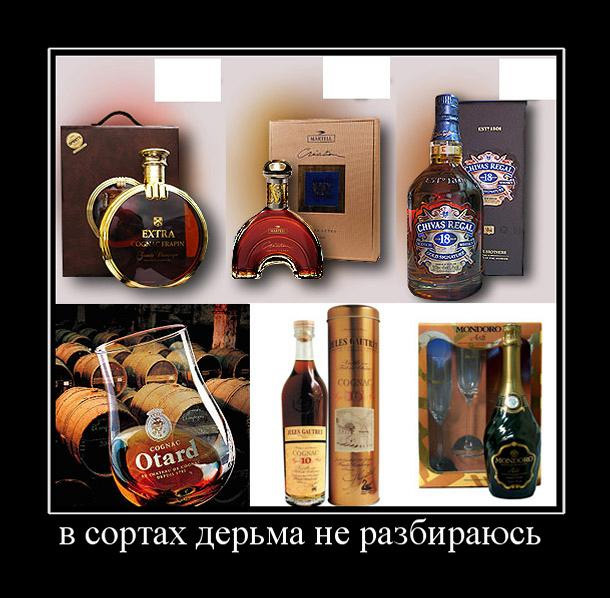
But the myth of "drinking culture" deserves separate consideration. According to propagandists of a sober lifestyle, all alcohol users can be considered as participants of one “pipeline”.
At the first level of this conveyor are children who have an inborn aversion to alcohol, and non-drinkers.
At the second level, “cultural drinkers” people who take alcohol rarely, in minimal quantities, prefer low alcohol drinks and enjoy the process, rejoice and have fun.
At the next levels there are drunkards and alcoholics who abuse strong drinks, which directly affects their health, social life and mental abilities.
The last stage of the pipeline is death.
So who is the propaganda of "cultural drink" intended for? Obviously not for alcoholics, for whom such propaganda is completely useless. And not to drunkards, because they are generally the most cultured people - raising a toast, they withdraw a finger, recite poems and quote great philosophers (as long as the brain is still functioning normally).
Obviously, propaganda is not intended for cultural drinkers - why, because they drink cultural too.
The only audience left is non-drinking people and children who have not yet formed alcohol dependence. It is precisely to them that the propaganda of “cultural drinking” from the alcohol lobby is aimed.
As a conclusion. Some time ago, a joke was popular in social networks: “Alcohol is completely eliminated from the body in 21 days. That is, never. ” Yes, it is ridiculous. But ethyl alcohol is a powerful psychoactive substance, it really changes the personality of a person. If the population of an entire country has been under the influence of alcohol for years, decades, centuries - what do you think will happen to this country? How balanced will its foreign policy be? What will be the level of political culture? How fast will the population decline?
How will the country change if you drastically reduce your alcohol intake? It is probably the easiest way to conduct such a psychological experiment as follows. Imagine that the traffic police suddenly abolish the "dry law" behind the wheel and allow you to drive while intoxicated. Any degree of intoxication. Imagine the chaos that will start on the roads, how much the number of accidents will grow. So, approximately in such a state of chaos there is now a country where the state makes alcohol as accessible as possible to citizens.

Source: https://habr.com/ru/post/397923/
All Articles